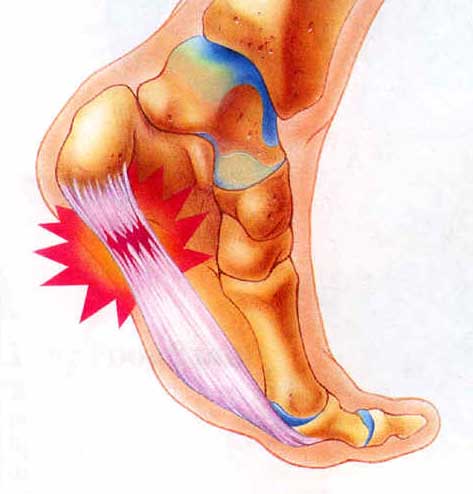Plantar Fasciitis Treatment

What is the plantar fascia?
The plantar fascia is a band of tissue on the bottom of the foot that attaches to the heel and all five toes. The plantar fascia has various functions. One function is to act as a protective layer for all the nerves, blood vessels, muscles, and bones of the foot. Another function is to support the arches of the foot while standing and during gait, making it a very important structure during walking.
At the heel strike phase of walking, the plantar fascia has some slack in it. This allows the foot to adjust to all the uneven surfaces that we walk on daily. During the stance phase, it helps to support the arches of the foot, so that the foot doesn’t collapse flat while bearing weight on that leg. During the toe off phase, the plantar fascia utilizes something called the windlass mechanism (a way to tighten a rope), to become taut and make the foot more rigid. This mechanism allows for the foot to be more efficient during propulsion.
Causes of Plantar Fasciitis
Now that we have discussed the various functions of the plantar fascia, we shall turn the attention to the term “plantar fasciitis.” This is not a great term for what this condition encompasses. The suffix “itis” means inflammatory diseases. So, in this case it would be inflammation of the plantar fascia. Which it was initially thought to be. However, this doesn’t seem to be consistent with what the current literature is saying. Instead, the term plantar fasciosis might be more accurate. “Osis” implying a pathological state of the plantar fascia.
Plantar fasciitis is caused by a biomechanical overuse of the plantar fascia, leading to microtearing of this tissue, usually around the heel. Which is why one of the more common symptoms of plantar fasciitis is heel pain, especially in the morning. The repetitive nature of walking, running, or improper foot biomechanics leads to chronic degeneration of the plantar fascia, which interrupts the “normal” healing process.
Plantar Fasciitis Treatment at Elite Sport & Spine
Evidence shows that High Load Strength Training (HLST) of the plantar fascia is a proven way to stimulate collagen production and potentially heal the degenerative changes within the plantar fascia. In our clinic, plantar fasciitis treatment is approached by our chiropractors like a tendonosis (E.g: Tennis Elbow). Meaning we want to load the tissue over time with increasing weight, to force the body to rebuild the plantar fascia and make it stronger. This is done by performing eccentric calf raises with a towel underneath the toes (above). Elevating the toes helps to reinforce the windlass mechanism that was discussed above. 1 set of 10 repetitions should be performed multiple times daily, with the plantar fascia feeling worked and fatigued. Once this is easy, a backpack can be worn and books can be added to slowly increase the load on the plantar fascia.
Soft Tissue Treatment
In addition to this, we utilize soft tissue techniques, like Graston Technique and myofascial release, to reduce the tension through the plantar flexor muscles of the ankle.
Manipulation or mobilization of ankle and hip joints also serve as an important part of treatment. This is to ensure that joints further up the kinetic chain are moving properly.
Some of the home exercises we prescribe for plantar fasciitis treatment may include improving strength of the ankle dorsiflexors, as well as increase the ankle dorsiflexion range of motion. Repeated ankle dorsiflexion mobilizations (above) is a great way to accomplish both of these tasks.
If plantar fasciitis is interrupting your life, our sports chiropractors would love to help you resolve this issue. We are more than happy to answer any questions you may have! You can schedule a free consultation online or call (262) 373-9168.
References
- Digiovanni BF, Nawoczenski DA, Malay DP, Graci PA, Williams TT, Wilding GE, et al. Plantar fascia-specific stretching exercise improves outcomes in patients with chronic plantar fasciitis. A prospective clinical trial with two-year follow-up. J Bone Joint Surg Am. 2006;88(8):1775–81.
- Robert Caratun, Nicole Anna Rutkowski, Hillel M. Finestone. Can Fam Physician. 2018 Jan; 64(1): 44–46.
- S. Rathleff, C. M. Mølgaard, U. Fredberg, S. Kaalund, K. B. Andersen, T. T. Jensen, S. Aaskov, J. L. Olesen. High-load strength training improves outcome in patients with plantar fasciitis: A randomized controlled trial with 12-month follow-up Scand J Med Sci Sports 2015: 25: e292–e300
 262-373-9168
262-373-9168



